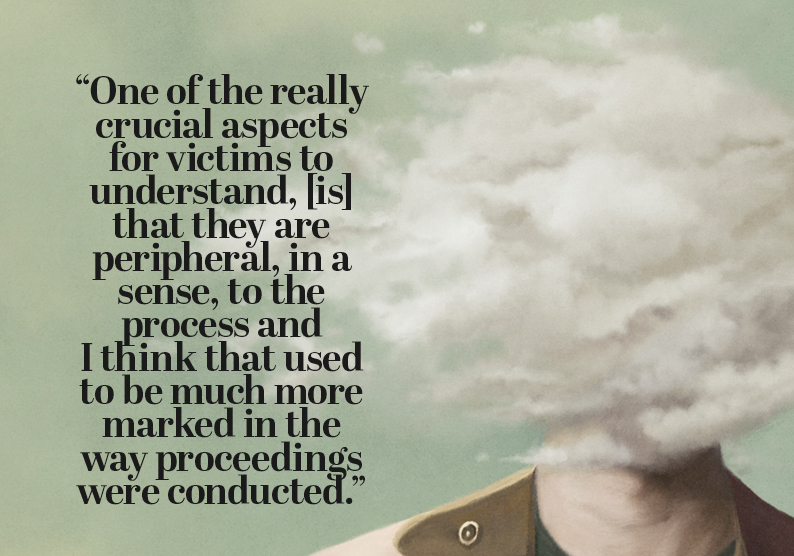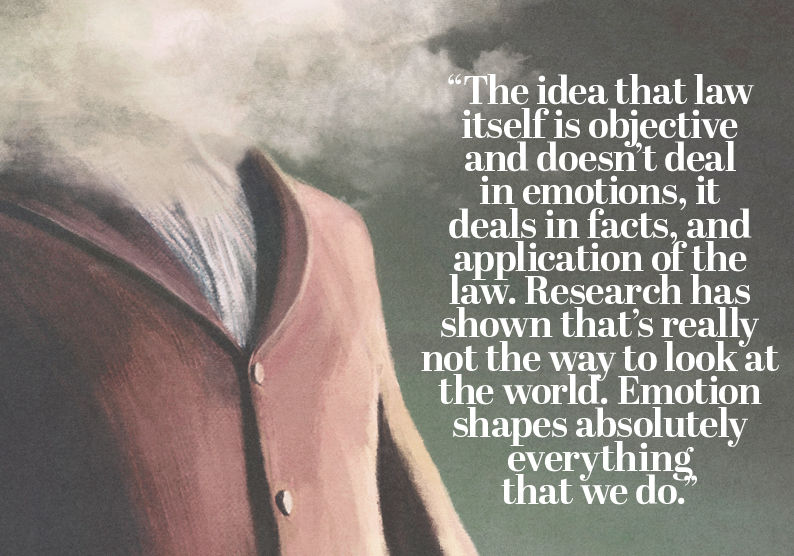Long-running, at times deflating and potentially re-traumatising, the administration of justice for serious crime can be a painful process. Why do victims of crime feel out of the picture, and what does this disconnect mean for overall confidence in the judicial process?
The politics of law and order can become particularly heated. Sentencing outcomes are criticised, and politicians are urged to change the law, so judges get “tough on crime”. The issue played a key role in recent elections in the Northern Territory and Queensland, where long-sitting Labor governments were turfed out of office. Reforms, including lowering the age of criminal responsibility to 10 in the Northern Territory and Queensland’s ‘Adult Crime, Adult Time’ pledge, appear to be popular but are also contentious among many who work in the criminal justice system.
In January, the sitting Labor government in Western Australia made a pre-election pledge to expedite Children’s Court matters, so that those charged with offences involving violence, who then allegedly re-offend while on bail awaiting trial, would stand trial within 28 days.
If we hit the rewind button in NSW, law and order was front and centre of the policy debate in the lead-up to the 2003 State Election. A number of court decisions attracted widespread media coverage and commentary. It was in this environment that the Labor government led by then-Premier Bob Carr, adopted a series of reforms aimed at promoting consistency and transparency in sentencing.
The changes included the introduction of standard non-parole periods as a guidepost for judges, aggravating and mitigating circumstances for individual offences and the establishment of a ‘Sentencing Council’, to provide advice to the Attorney General on sentencing matters. The events of this period are detailed in an episode of the Sentencing Council’s podcast series Sentencing Explained.
In parliament at the time, Attorney General Bob Debus was at pains to point out the reforms did not amount to mandatory sentencing and would not replace judicial discretion. “By introducing a regime of standard non-parole periods for a specified number of serious offences, the Government will ensure not only greater consistency in sentencing but also that proper regard is given to the expectation of the community that punishment is imposed which is commensurate with the gravity of the crime.”
More than 20 years on, NSW may have avoided a repeat of the ‘law and order auction’, but why then are sentencing outcomes still the subject of such controversy for many victims? What role do victims even play in the criminal justice system? And what about when an offender comes up for parole?
The perspective of victims
One man who knows the system’s strengths and weaknesses better than most is victims’ advocate Howard Brown. He’s been a tireless voice for victims since 1989, the year after a close friend of his was murdered.
“I realised that victims of crime were just abandoned. There was no one there to help pick up the pieces, to guide them, to give them any direction. And I thought, well this stinks,” he tells the Journal.
It’s now four years since Brown’s right leg was amputated above the knee, due to a life-threatening medical emergency. He doesn’t appear to have slowed down or lost any of his steely resolve to assist people having to navigate what can be a torturous path.
Brown has witnessed and campaigned for many of the major reforms that relate to victims over the past few decades. However, he’s still troubled by some of what he sees. “[T]he more things change, the more they stay the same. Because I have seen a gradual degradation in the way victims are being treated and especially since COVID,” he says.

Victim not a party
In our adversarial court system, victims are not a party to criminal proceedings. Charges are brought by the Crown, on behalf of the State.
Tracey Booth is a Professor in the Law Faculty at the University of Technology, Sydney (UTS). She has researched and written extensively about the experience of victims in criminal proceedings, including through Victim Impact Statements (VISs).
“Victims feel forgotten because of the way we structure sentencing, because of the way we structure our criminal justice system,” she outlines to the Journal.
“[Y]es, somebody suffered individually, but the crime is really against the community or against the society and so you lose control … even though it personally affected you.”
Brown agrees with this assessment of a victim’s standing. “[T]he problem is you are still only a witness in the case. And so they say, look, this is complex legal matters. You’re a plumber, so you know nothing about the law, so we’ll just ring you when we need you,” he says.
For Booth, managing the expectations at the many different stages of the process, is key to how victims will experience what ultimately happens. “That’s one of the really crucial aspects for victims to really understand, that they are peripheral, in a sense, to the process and I think that used to be much more marked … in the way proceedings were conducted.”
Rights of victims enshrined
The Charter of Victims Rights was introduced as part of the Victims Rights and Support Act 2013. In 18 subheadings, it sets out what victims should expect and are entitled to. The charter covers everything from respect to information about investigations and prosecutions, as well as bail and parole.
Brown believes the Charter is not doing its job, particularly when it comes to communication by the ODPP if charges are changed or dropped. “They’re supposed to consult. They don’t consult, they tell you, they dictate to you,” he says.
For its part, the ODPP says it takes its obligations under the charter very seriously. “The ODPP treats victims with courtesy, compassion, cultural sensitivity and respect,” says a spokesperson. “Victims are kept informed of relevant developments in their cases and are consulted on significant decisions that affect them.”
ODPP lawyers are provided with training and resources in trauma informed practices, including communication with victims. Those lawyers are supported by officers from the ODPP’s Witnesses Assistance Service (WAS).
This is a team of 62 people, including 12 Indigenous officers, who are based across the state, made up of social workers, psychologists and counsellors. An ODPP spokesperson says WAS officers, “understand the criminal justice system and are able to help complainants and families navigate the … process.”
When it comes to important decisions, such as amending or discontinuing charges, the ODPP says consultation with victims is required under both the charter and the Prosecution Guidelines. “ODPP staff arrange conferences to seek views on any proposed decision and to explain the legal process in a trauma-informed way,” says a spokesperson.
The ODPP points out that while it recognises the important role of victims, it does not act on behalf of individual victims. “[T]he ODPP is an independent agency whose principal role is to prosecute serious crime in NSW independently …”
Howard Brown says he’s been working to assist the grandparents of a young murder victim. The victim’s mother was killed in an unrelated car accident, two months after her son was killed. Brown says the victim’s father became the principal contact and the grandparents have been shut out of communications about the prosecution.
“[T]hey have been completely abandoned during the process and it’s their grandson. It’s their daughter’s son. They feel that they need to honour their daughter to ensure that the punishment that is meted out … (is) adequate,” says Brown.
In response to a question about how the ODPP handles a situation where family members are estranged from the principal family contact, a spokesperson says “The ODPP may be informed that there are estranged family members by the OIC (police officer in charge), by the senior next of kin, or where the legal team is contacted directly by the other family member. In these circumstances, the ODPP will liaise with those other family members and share information and take into account their views as considered appropriate in the circumstances.”

Our legal system
Professor Tracey Booth says there are historical reasons for the way courts currently operate, which mean there is an overwhelming focus on an accused person. “[T]he idea being you need to have protections in place because you have the might of the state pitched against you,” she says.
“[W]e have rules of evidence, we have rules of procedure, we have all of these rules that protect the defendant, who is always presumed innocent until proven guilty. And this is historical, because … when we came into the modern trial, say the early nineteenth century, offenders had no rights, and it was really grossly unfair as to the way that they were tried.”
A recent report by market research company Fiftyfive5, commissioned by the NSW Road Trauma Support group, found that 67 per cent of those navigating the judicial system after their loved one was killed in a fatal road crime, “often or always felt that they were battling against a system not designed to help people in their situation.”
“Families of victims of fatal road crimes often speak of feeling that throughout the judicial pathway, the needs of the offender who killed their loved one are given precedence over not just their own experience, but often overshadowing the life of the person who has been killed,” the report says.
One of the main ways that victims are acknowledged and are able to participate in the criminal justice system is through Victim Impact Statements, which can be delivered orally in a courtroom. These statements are capable of powerfully articulating the consequence of a serious offence, not only to a victim or close relative, but also the broader community.
Their incorporation into sentencing proceedings has not been without issue. From the perspective of a defence team, they can be seen to be unhelpful to the interests of an offender.
Emotion and the law
In her 2016 book Accommodating Justice: Victim Impact Statements in the Sentencing Process, Booth wrote about the “emotionality and subjective nature of victim impact statements”, and the view that this can undermine the right to a fair hearing.
Booth says there is an obvious clash. “[T]his traditional idea that emotion, any sort of display of emotion, potentially can be uncontrollable, can be polluting, can have really negative impacts on decision making. And the idea that law itself is objective and doesn’t deal in emotions, it deals in facts, and application of the law,” she says.
Booth argues this doesn’t really reflect reality. “[I]n the last decade, research has shown that that’s really … not the way to look at the world. Emotion just shapes absolutely everything that we do.”
Tensions often arise when Victim Impact Statements are edited or filtered, usually by a prosecutor, to ensure they comply with the rules and only relate to the impact of the offence for which the offender has been convicted.
Howard Brown says this can be a crushing moment for victims. “And so, all of the sudden, those things that you want directed to the perpetrator so that they actually take full responsibility for what they’ve done, they have to be removed. And again, because of this poor communication set between prosecutors and victims, often that editing does not take place ‘til the day.”
The ODPP says victims are provided with a written guide on the purpose and scope of a VIS and are told that the defence may object to certain content and this may be upheld by the court. “[T]he ODPP also has a responsibility … to ensure that any VIS complies with the legislation, including that it does not contain material that is offensive, threatening, intimidating or harassing,” says a spokesperson.
Other inadmissible material, including allegations that go beyond the offence for which the offender is being sentenced, have to be removed before the statement is tendered. “If the legal team feel amendments need to be made to the VIS, they will consult with the victim and look for solutions before making any amendments,” says the ODPP spokesperson.
Booth witnessed many Victim Impact Statements being delivered, as part of her extensive research on the subject. “I’ve seen some, where I thought the victim was treated really badly,” she says. “Made to stand there, shaking like a leaf, nothing to put their statement on, and I thought that was really rude. I’ve seen proceedings where a victim read their Victim Impact Statement and it was incredibly moving and before they got back to their seat, the court had started again.
“But I think a lot of sentencing judges do it well. They acknowledge the victim … which is great, because I think it’s important, you feel, ‘Oh, somebody heard me, somebody’s recognised this’, even if you don’t get the penalty you necessarily think somebody should.”
The pitfalls of parole
Another key part of the criminal justice system where victims sometimes feel forgotten is parole. Former Judge of the Supreme Court, Geoffrey Bellew SC is Chair of the NSW State Parole Authority (SPA). Last year, at the Law Society’s Annual Conference, he described how he and other SPA members, several times a week, were having to make “extraordinary decisions” with ramifications for individuals and the community.
Bellew believes that much of the public criticism of parole determinations stems from a lack of understanding about how the process works, leading to common misconceptions. One of them is when parole is referred to as a form of early release. “[I]f an offender is released at the end of the non-parole period, it’s not early release at all. It is release at the end of the minimum period in custody that the sentencing judge thought appropriate be served.
“The second (misconception) is the notion that serious criminals should never ever be released. That’s a fallacy and the reason it’s a fallacy is because under our sentencing laws, unless a person is sentenced to life imprisonment, he or she will be released at some point.”
Another common error Bellew hears is reference to people “walking free” on parole. “The notion that somebody walks completely free from custody when they’re released on parole is just nonsense,” he says. That’s because there are conditions attached to the release, including supervision.

Community safety
The State Parole Authority must be satisfied that releasing someone on parole is in the interest of community safety. “And considerations of community safety involve a multitude of factors, some narrow, some broad and often the factors that we have to consider pull in different directions,” says Bellew.
SPA members sit as a board which includes community representatives. “The strength is that you have five people with different qualifications and different backgrounds coming together and bringing their differing experience to the making of an obviously difficult decision,” he says.
“[A]nd amongst our community members, we have a great diversity of experience and qualifications. We have people with qualifications as psychologists. We have people experienced in dealing with those suffering from mental health issues. We have people who have done work with victims. We have people who work with the homeless. We have people who have experience at high levels of law enforcement, some of whom have particular expertise in the issues which underlie gang-related and terrorism-related offending.”
Bellew says the significance of regularly making parole determinations isn’t lost on him. “They weigh extremely heavily on me. I can’t speak for anybody else. I can only speak for myself although knowing our members as I do, I can say without any hesitation that each of them takes their position extremely seriously and recognises the importance of the decisions that they are called upon to make.”
“There are some particular decisions, and I won’t go into detail, but there are some particular decisions over which I have agonised, but I’ve come to the conclusion that in the exercise of a very broad based and independent discretion, we should have done … what we ultimately did.”
Bellew draws parallels with his former role on the Supreme Court bench. “In a sense, it’s not unlike sentencing people when you’re a judge. Sentencing, the task of sentencing always used to weigh heavily on me because depriving a person … of their liberty is significant. In many ways, deciding whether to release an offender into the community is just as significant.”
When a decision is taken to release an offender on parole, this is often criticised, because of concerns about the possibility of reoffending. Bellew says it’s a stark predicament.
“We are often faced with a choice of releasing a person under conditional and supervised parole for a period of time, thus assisting them to reintegrate into the community or leaving them in custody until a time at or about the expiration of their sentence. The effect of which will be that they have no supervision and no support at all.”
He says that’s akin to knowing the person has a drug problem, no family, no support, nowhere to live and no job, and simply opening the door and saying, “best of luck”.
“The alternative to that is to have support, have somewhere to live, have some assistance in trying to find employment, have access to support services and address the issues, be they drug-related, violence-related, or whatever, under the umbrella of a specifically formulated risk mitigation plan, under supervision. I would think that if those alternatives were better understood, most people would perhaps have a better appreciation of the process and would realise that, in terms of community safety, having somebody supervised under that sort of regime is likely to be more conducive to that safety than just leaving them on their own.”
Bellew says that does not mean everyone will be suitable for parole. “We rarely hear the good stories … generally, we only hear the bad ones. None of this is to say that there are not cases where, because community safety underpins everything that we do, offenders have to be kept in custody because of, for example, violent tendencies which render the risk of release into the community just too great.”
According to 2022 figures from the NSW Bureau of Crime Statistics and Research, 23.4 per cent of adults found guilty, reoffended in the following 12 months. The figure was slightly down on the previous year, but higher than the latter half of the 2010s. For Aboriginal adults, the reoffending rate was 42.7 per cent. For young people, the figure was 44.6 per cent.

The Canadian experience
In his address to the 2024 Law Society Annual Conference, Geoffrey Bellew spoke about the different approach taken by Canadian authorities, in preparing victims for parole decisions. He tells the Journal it’s something he’s also taken up with the Premier and Minister for Corrections. “What the Canadians do well is that they engage with people very early, about … 18 months to two years away from the proposed release,” he says.
Bellew explains that the authorities there recognise that the chances of further trauma are high. “[S]o they make available various community services, counselling services and the like, that victims can avail themselves of if they’re re-traumatised. Importantly, they also educate them about the whole parole process.”
Victims are given the opportunity to draft submissions or an oral statement during a hearing. “[T]hey ensure, at the back end, as it were, that those same support services that they arranged at the beginning are there at the end,” says Bellew.
“So, it’s a wraparound service. I thought that that was something that they did very well, and I thought it was something, and I still think it’s something that we can learn from. I would like to see that kind of approach implemented as part of our processes in NSW. It is something that is presently the subject of ongoing discussion and consultation.”
Howard Brown says parole determinations can pose a dilemma. “What do you do with really difficult offenders? Do you just wait ‘til their sentence expires and then just let them out without any supervision, without any direction?”
He says there are obvious benefits to the supervision that occurs when someone is released on parole, with a sufficient period left on their sentence.
“It’s getting that information to the victims, so that they understand the process, that’s so important and it’s not really happening.”
Communicating with victims
The mechanism for informing victims about an offender’s situation is the Victims Register operated by Corrective Services NSW. Direct victims, immediate family members of victims who died from the crime or a direct victim’s primary caregiver are eligible to be added to the register.
Victims can be updated on things like sentencing details, an offender’s location and security classification, if an offender escapes custody, or if they die during their sentence.
In 2006, new legislation introduced Extended Supervision Orders (ESOs) and Continuing Detention Orders (CDOs) for high-risk offenders. The laws gave the Supreme Court the power, on application, to order that a serious offender be supervised in the community or held in custody, after their sentence expires.
In 2017, the laws were reformed to clarify that community safety was the paramount consideration when deciding whether to issue a CDO or ESO. The test for making a CDO was also strengthened, so an offender’s risk to the community was considered, rather than whether they could be adequately supervised.
The changes also sought to inform registered victims if an offender is being considered for a CDO or ESO. This was meant to give them the opportunity to provide a written or oral statement to the Supreme Court.
“We’ve got … 200 people currently on either ESOs or CDOs here in NSW,” says Howard Brown. “That tells me two things. One, we’re not doing the right thing with them in custody because they’re clearly not rehabilitated and then secondly, when you look at the breaches of these orders … it actually demonstrates why we fought so hard … (for) the high-risk offenders legislation …”
Information about high-risk offender management posted online by the Department of Communities and Justice says, “There is only a small number of high-risk sex and violent offenders in NSW, but their crimes have a significant impact on victims, victims’ families and our communities.”
Brown says the laws are tough but necessary. “I am the first to put my hand up and say that this is draconian legislation, but we live in a democracy where majority rules. And when you consider how dangerous this small cohort is, in relation to the rest of the community, it is a small price that we pay to protect 99.9 per cent of the community.”

VISs in the Netherlands
In 2018, Tracey Booth co-authored an article in the British Journal of Criminology, which examined the use of Victim Impact Statements (VIS) in the Netherlands, a country with an inquisitorial legal system. The article observed that research in countries with adversarial systems, such as Australia, “has identified a range of legal and institutional constraints that significantly curtail victims’ voices through VISs in legal proceedings.”
The authors concluded that their study of Dutch court proceedings revealed that victims were given greater scope to speak and be heard. “In particular, the greater reliance on judges to determine the weight given to the evidence rather than strict rules of evidence enhanced victims’ capacity to speak.”
Speaking to the Journal, Booth says the interpersonal treatment of victims by judges is crucial. She recalls one case, where mental illness was taken into account by a judge who sentenced a young man for the murder of another young man. The case also involved drugs and alcohol.
Booth says the judge explained to the victim’s mother that the offence was really serious, but the sentence wouldn’t be what she might have expected, because of the factors that had to be considered.
“I don’t know that they (were) happy (or) unhappy about the penalty, but they understood, and they weren’t angry with the justice system.”
It is often left to people like Howard Brown to help victims make sense of it all. “[Y]ou’re there to hold their hand and to demystify the process but no one in government, none of the prosecutorial agencies are interested in doing that. And what I’m saying sounds terrifically critical of them and I don’t mean it to actually be critical because it is unbelievably difficult to both prosecute and to defend a matter.”
Sentencing considerations
The purposes of sentencing are detailed in Section 3A of the Crimes (Sentencing Procedure) Act 1999. They include punishment, prevention, community protection, rehabilitation, accountability, denunciation and recognition of harm.
As outlined in the High Court judgment Muldrock v The Queen (2011), the purposes overlap and are sometimes conflicting, but there is no ranking of their order of priority. A failure to consider the purposes of sentencing at all, would be considered an appellable error.
Brown concedes that over time, there has been a change in the way offenders are being punished. “Sentences have got longer, there’s no question about that. But I don’t believe it’s because of Victim Impact Statements. But that was never our intent when we sought to have Victim Impact Statements put in the court. We wanted perpetrators to be confronted by the people or their families that have been aggrieved and to explain to them exactly what they have done and how it has impacted (them).”
He says the trend of longer sentences has more to do with the introduction of aggravating and mitigating circumstances. “One of these aggravating features … is the constant breaching of an apprehended violence order and ensuring that the court does take that into account when formulating a sentence.”
Professor Tracey Booth agrees that the treatment of victims has the potential to undermine public confidence in the administration of justice.
“We just have to develop more empathic responses to people who need support in courtrooms, who need support in justice processes,” she says.
“We need to think about the people involved and we have to think about it at lots of different stages. I think we can’t just say, ‘Oh, well what happens in court is the most important,’ because I don’t think it is.”
When it comes to parole, Geoffrey Bellew SC says victims are one part of the process. “The interests of victims is something … to which we must have regard, and we do, but there is never any one factor that determines what decision we make.
“There are a series of factors that we must, by law take into account. The position of victims is one of them.”
One thing is certain. The experience of victims throughout the many stages of the criminal justice process is key to maintaining public confidence in the rule of law. NSW has a proud legal tradition. Ensuring the rights of all are defended, at the same time as remembering the interests of those who feel forgotten, will build on that foundation.




